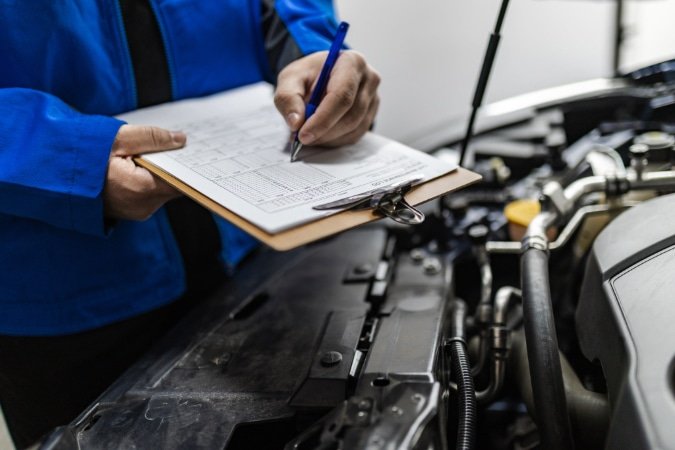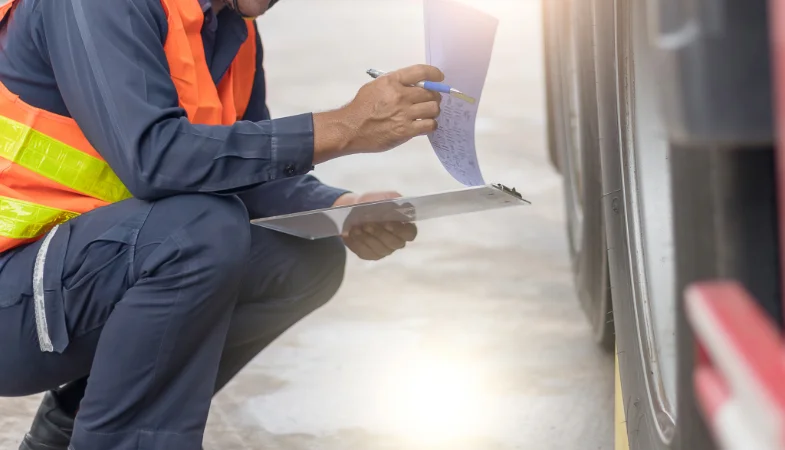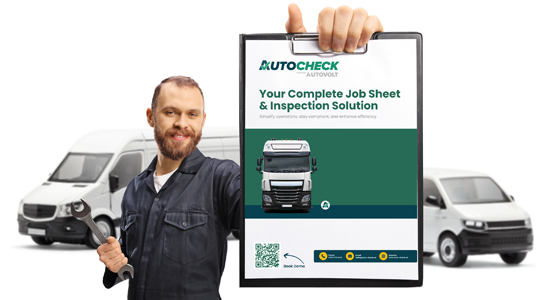Can better vehicle check processes reduce accidents?
Vehicle checks are the first line of defence for road safety.
If we do checks incorrectly, our vehicles are at higher risk of causing collisions due to mechanical failures such as defective brakes, tyres, steering, or lighting systems.
‘A robust maintenance regime depends on drivers carrying out risk-based walk-around checks, prompt defect reporting, and regular, scheduled preventative maintenance inspections.’ – Traffic Commissioners for Great Britain: Annual Report to the Secretary of State 2024-2025
Thorough vehicle checks can reduce the risk of collisions, protecting lives. They can reduce downtime, as police and DVSA officers can stop you to do checks on your vehicles, but are less likely to find defects if the vehicle has already been checked in the past twenty-four hours. They can prevent prohibitions, such as being stopped from driving until problems are fixed, being issued with a fine, or facing a prison sentence for using a vehicle in a dangerous condition.
The Legal Framework
According to operator licence conditions, it is the operator’s duty to keep vehicles roadworthy. Operators should be aware that a minimum of one walk-around check must be carried out at least once in a twenty-four-hour period that the vehicle is used.
The DVSA can ask for a record of a walk-around check at a roadside check to ensure the vehicle is safe. The guide to maintaining roadworthiness outlines that the driver is always legally responsible for the condition of the vehicle while in use. Therefore, conducting a daily walk-around check is a vital part of a driver’s core role.
Any report listing defects becomes part of the vehicle’s maintenance record, including electronic records of reported defects, and must be kept for at least fifteen months, alongside details of any assessment, rectification work, and the repairer.
What do good check processes look like?
Good check processes look like clear, standardised checklists that cover the whole vehicle including all interior and exterior items that can be safely assessed without the use of a workshop. The DVSA recommends using a form that includes a list of the items checked each day, and to record ‘nil’ defects if no defects are found. You can download a template to use or use the system that your employer provides.
Vehicle checks are different for HGVs and PSVs, but you should always allow plenty of time to check your vehicle is safe before you drive. Remember this counts as working time, and if your vehicle is not safe, you risk an incident, prohibition, fine, and penalty points on your licence.
You can complete vehicle checks digitally or on paper, as long as the records are kept available for fifteen months. The process should involve both drivers and the workshop, as they share responsibility for the vehicle’s roadworthiness.
What is the role of daily walk-around checks?
The DVSA requires operators to follow the proper vehicle construction, road safety, environmental, and operating standards required by law in the UK. They state that record-keeping is necessary, and that drivers are responsible for the condition of their vehicle when in use. Any defects found during the daily walk-around check, while the vehicle is in use, or on its return to base, must be reported according to the guide to maintaining roadworthiness.
Completing and keeping ‘nil’ defect reports is a useful means of checking that drivers are carrying out their duties, and these forms can be used for audit purposes.
If we don’t do vehicle checks correctly or at all, it can have a real-world impact. Something as simple as missing a tyre defect or a loose wheel nut can cause major accidents.
What about first-use and ad-hoc checks?
Vehicles coming out of storage, hire, or maintenance may require multiple checks during the twenty-four-hour period, with a focus on systems and parts which are likely to face damage before returning to the road.
This can prevent immediate prohibitions at roadside checks, because if a defect is found then drivers can be stopped from driving until the defect is fixed, or they can be issued with a fine.
Recording and Reporting Defects
Drivers should record and report all defects that they find during the daily walk-around check to the garage or operator. If drivers become aware of defects during their journey, they should find a safe place to stop to assess and report any defects to the garage or operator. The DVSA states that dangerous defects must be fixed before the journey is continued.
There must be a system of reporting and recording defects that affect the roadworthiness of the vehicle, and this must include how they were rectified before the vehicle was used. Linking defects to job sheets leads to timely repairs and efficient record-keeping.
Daily defect checks are crucial, and defect reporting is one of the fundamental elements of any effective vehicle roadworthiness system. Ignoring minor issues until they escalate can lead to dangerous mechanical failures, increasing the risk of collision as well as the risk of receiving prohibitions.
How can using technology improve checks?
Our Driver Defect App makes daily walk-around checks and driver defect reporting quick, easy, and compliant. Drivers can complete inspections from their mobile app, with time-stamped records, photo uploads, and instant roadworthiness confirmation.
Any defects are flagged immediately and sent to the workshop for action, keeping repairs on track. Every check is stored securely against the vehicle for a complete audit trail.
Advanced driver assistance systems can also be included in checklists, covering systems such as automatic emergency braking, adaptive cruise control, lane keeping assist, and blind spot detection.
Case Studies and Common Failures
It is the operator’s responsibility to ensure that all vehicles are kept in a roadworthy condition. When an operator failed to carry out brake performance assessments during safety inspections and vehicles were presented with dangerous defects, a transport manager was disqualified from managing transport for a year and would have to resit and pass the Transport Manager Certificate of Professional Competence again after the year had passed.
It is important that drivers are aware of the overall vehicle dimensions, including trailer and load. It is also important to consider route planning before a driver starts their journey if low bridges need to be avoided.
‘32% of drivers set off whilst not being aware of the height of their vehicle, and 56% don’t consider low bridges when planning their journey.’ – Network Rail
When an operator’s vehicle was involved in a bridge strike after being improperly allocated to a driver, the Traffic Commissioner issued a formal warning, but the case led to significant financial loss for the operator.
In October 2024, the Senior Traffic Commissioner reissued guidance to operations of large vehicles, highlighting the costs of accidents which pose serious safety risks and financial burdens, including infrastructure damage, service disruptions, and potential regulatory penalties.
Learn how to prevent vehicles from hitting bridges here.
How can we build a safety culture?
Drivers must be made aware of their legal responsibilities regarding vehicle condition and the procedures for reporting defects, and operators must ensure that drivers are sufficiently trained to do so. This may be part of their Driver’s Certificate of Professional Competence training. Drivers need to take checks seriously as they share responsibility for the vehicle’s roadworthiness with the operator and may be fined or prosecuted for roadworthiness offences found on vehicles if they are found responsible. Traffic Commissioners can take action against a driver who fails to complete a satisfactory walk-around check, which could lead to a driver conduct hearing, and can result in the loss of the vocational driving licence.
Traffic Commissioners have supported the launch of the Maintenance Provision Rating Scheme designed to enhance standards and professional practices within the commercial vehicle maintenance sector.
A safety culture can be built by focusing on rewarding good reporting habits such as regular checks and ‘nil’ defect reporting, rather than penalising drivers who find defects.
In conclusion…
Remember that better checks mean fewer accidents, fewer prohibitions, and less downtime.
You can review your current check process against DVSA standards by looking at the following guidance:
How to carry out HGV daily walk-around checks
How to carry out bus or coach daily walk-around checks
If you’d like to learn more about our Driver Defect App, Book a Demo





